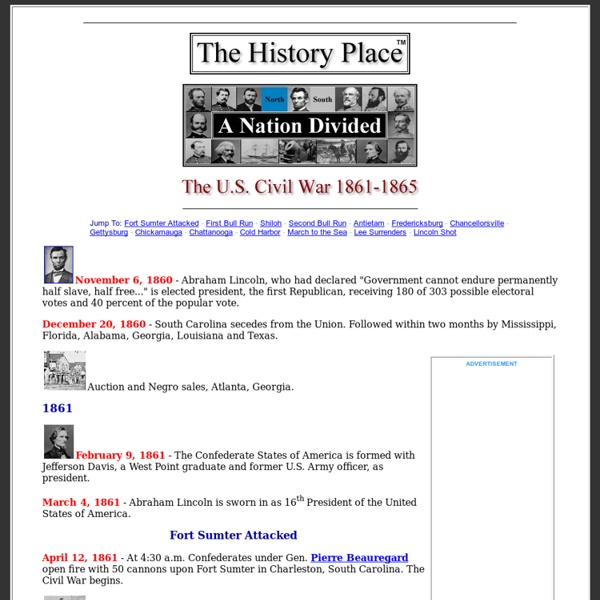Post-1865: Effects of the War
By the Civil War Trust, Endorsed by History™ Grades: Middle School Lesson Downloads
The Civil War
First Battle of Bull Run Kurz & Allison Civil War Facts Location Eastern Theater, Western Theater, Trans-Mississippi, Gulf Coast, Sioux Uprising
Putting CW Casualties in Perspective
Civil War Deaths and 9/11 Printable Version Digital History ID 4520From the National Park Service: The Journal of Heritage Stewardship, Volume 4, Number 2, Summer 2007, by John A. Latschar, Ph.D., the superintendent of Gettysburg National Military Park in Pennsylvania. In 1860, the total population of the United States was 31.4 million; 3.8 million men - approximately 12 percent of the total population - were enrolled in military service; 620,000 lost their lives (2 percent of the total population) in the war.
A Brief Overview of the American Civil War
Abraham Lincoln (National Archives) The Civil War is the central event in America's historical consciousness. While the Revolution of 1776-1783 created the United States, the Civil War of 1861-1865 determined what kind of nation it would be. The war resolved two fundamental questions left unresolved by the revolution: whether the United States was to be a dissolvable confederation of sovereign states or an indivisible nation with a sovereign national government; and whether this nation, born of a declaration that all men were created with an equal right to liberty, would continue to exist as the largest slaveholding country in the world.
Gettysburg Address
Printable Version Gettysburg Address Digital History ID 4014 Author: Abraham Lincoln Date:1863 Annotation: The Gettysburg Address was delivered on November 19, 1863, several months after the Union defeated the Confederacy at the Battle of Gettysburg.
American Civil War History - American Civil War
In the mid-19th century, while the United States was experiencing an era of tremendous growth, a fundamental economic difference existed between the country’s northern and southern regions. In the North, manufacturing and industry was well established, and agriculture was mostly limited to small-scale farms, while the South’s economy was based on a system of large-scale farming that depended on the labor of black slaves to grow certain crops, especially cotton and tobacco. Growing abolitionist sentiment in the North after the 1830s and northern opposition to slavery’s extension into the new western territories led many southerners to fear that the existence of slavery in america—and thus the backbone of their economy—was in danger. In 1854, the U.S. Congress passed the Kansas-Nebraska Act, which essentially opened all new territories to slavery by asserting the rule of popular sovereignty over congressional edict.
1860-1861: The Country Goes To War
By the Civil War Trust, Endorsed by History™ Grades: Middle School Lesson Downloads Common Core Standards NCSS Standards
Radical Republicans
Dueling Plans The summer of 1864 was a tense time for Lincoln. The man that we think of as being a great American hero was fighting to save his job.



